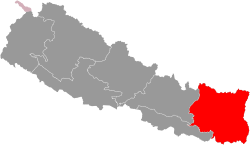Koshi Province
कोशी प्रदेश Kōśī pradēśa | |
|---|---|
|
| |
 Location of Koshi Province in Nepal | |
Koshi Province | |
| Coordinates (Biratnagar): 26°27′15″N 87°16′47″E / 26.45417°N 87.27972°E | |
| Country | |
| Formation | 20 September 2015 |
| Named as Koshi | 1 March 2023 |
| Named for | Koshi River |
| Capital | Biratnagar[1] |
| Largest city | Biratnagar |
| Districts | 14 |
| Government | |
| • Type | Self-governing Province |
| • Body | Government of Koshi Province |
| • Chief Minister | Hikmat Kumar Karki[2] (CPN UML) |
| • Governor | Parshuram Khapung |
| • High Court | Biratnagar High Court |
| • Koshi Provincial Assembly | Unicameral (93 seats) |
| • Parliamentary constituency | 28 |
| Area | |
• Total | 25,905 km2 (10,002 sq mi) |
| • Rank | 2nd |
| Highest elevation | 8,848.86 m (29,031.69 ft) |
| Lowest elevation | 58 m (190 ft) |
| Population (2021)[3] | |
• Total | 4,961,412 |
| • Rank | 4th |
| • Density | 192/km2 (500/sq mi) |
| • Rank | 4th |
| • Households | 1,191,556 |
| Demonym(s) | Purbeli, Kosheli, Koshyali |
| Demographics | |
| • Religions | |
| • Ethnic groups | |
| • Sex ratio | 91.48 ♂ /100 ♀ (2011) |
| Development Parameters | |
| • GDP per capita | US$1267 (3rd) |
| • Poverty rate | 0.127[6] |
| • Literacy | 79.7% |
| • Life expectancy | 69 |
| • HDI | 0.553 |
| Time zone | UTC+5:45 (NST) |
| Geocode | NP-ON |
| ISO 3166 code | NP-P1 |
| Vehicle registration | KOSHI XX AB XXXX |
| Official language | Nepali Limbu[7] |
| Other Official language(s) | Bantawa |
| GDP (Nominal) | US$9 Billion (2nd) |
| Website | koshi |
Koshi Province (Nepali: कोशी प्रदेश) is the autonomous easternmost province adopted by the Constitution of Nepal on 20 September 2015. The province is rich in natural resources, tourist attractions, recreational activities, and natural beauty.[8] The province covers an area of 25,905 km2 (10,002 sq mi), about 17.5% of the country's total area. With the industrial city of Biratnagar as its capital, the province includes major eastern towns of Birtamod, Sundar Haraincha, Damak, Dharan, Itahari, Triyuga Municipality and Mechinagar, and the Mount Everest, Kangchenjunga and Ama Dablam. Koshi River, the largest river of the nation, forms the province's western boundary. Under the First-past-the-post voting system issued by the Constituency Delimitation Commission, Nepal, the province hosts 28 parliamentary seats and 56 provincial assembly seats.[9]
The province is bordered by the Tibet Autonomous Region of China to the north, the Indian states of Sikkim and West Bengal to the east, Bihar to the south, and Bagmati Province and Madhesh Province to the west.[10][11][12] According to the 2021 Nepal census, there are around five million people in the province, with a population density of 190 per square kilometre.[13] In the 2011 Nepal census, the province had approximately 4.5 million people.[14]
- ^ Cite error: The named reference
capitalwas invoked but never defined (see the help page). - ^ "मध्यावधि रोक्न सांसदहरूले मलाई समर्थन गर्नुभयो : मुख्यमन्त्री कार्की" [MPs supported me to block mid-terms: CM Karki]. Online Khabar. 2023.
- ^ "National Population and Housing Census 2021". Government of Nepal, National Statistics Office. 2023.
- ^ "NepalMap profile: Province No. 1". Archived from the original on 25 January 2021. Retrieved 8 March 2020.
- ^ "NID | Overview". Archived from the original on 26 October 2020. Retrieved 7 February 2021.
- ^ "Province Wise Multidimensional Poverty Index". Archived from the original on 20 September 2020. Retrieved 7 February 2021.
- ^ "सरकारी कामकाजको भाषाका आधारहरूको निर्धारण तथा भाषासम्बन्धी सिफारिसहरू (पञ्चवर्षीय प्रतिवेदन- साराांश) २०७८" (PDF). Language Commission. Archived from the original (PDF) on 6 September 2021. Retrieved 28 October 2021.
- ^ "Nepal Provinces". statoids.com. Archived from the original on 18 July 2017. Retrieved 21 March 2016.
- ^ "Editorial: Important step". The Himalayan Times. 2017. Archived from the original on 5 September 2017. Retrieved 5 September 2017.
- ^ "Biratnagar celebrates its status of provincial capital". The Himalayan Times. 2018. Archived from the original on 20 January 2018. Retrieved 19 January 2018.
- ^ "Locals intensify protest in Dhankuta after Biratnagar named as provincial HQ". Kathmandu Post Ekantipur. 2018. Archived from the original on 18 January 2018. Retrieved 19 January 2018.
- ^ "Nepal government announces Provincial Capitals and Chiefs". DDI News. 2018. Archived from the original on 19 January 2018. Retrieved 19 January 2018.
- ^ "राष्ट्रिय जनगणना २०७८ प्रारम्भिक नतिजा". cbs.gov.np (in Nepali). Central Bureau of Statistics, Nepal. 2022. Archived from the original on 26 January 2022. Retrieved 26 January 2022.
- ^ "Province 1: Call for opportunities in the land of great promise". Kantipur Publications Pvt. Ltd. 2015. Archived from the original on 6 September 2017. Retrieved 5 September 2017.





